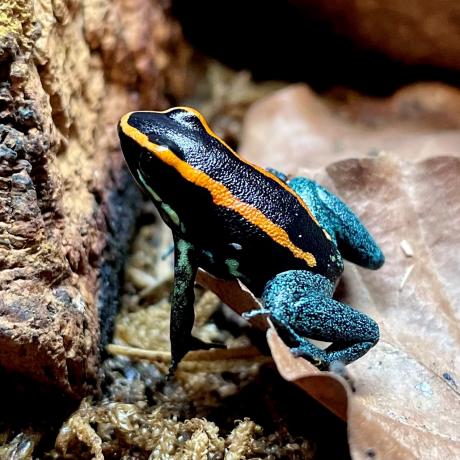

Golfodulcean Poison Dart Frogs reach an average length 3.5cm and display vibrant orange stripes down their backs. They are named after the Golfodulcean region of Costa Rica and are considered endangered in the wild due to habitat loss.
Golfodulcean Poison Dart Frogs are a moderately sized species, reaching a length of around 3.5cm. This frog appears almost glittery due to chemical pigmentation in the skin, the base colour of black is lined with two vibrant orange stripes which run from nose to cloaca, these stripes is where the name vittatus, meaning ‘banded’ originates. The stripes can occasionally also be seen in golden, yellow and green. The legs are mottled blue and this pattern runs upwards towards the sides where it is mottled blue or green. Females are usually larger than males, and both sexes will appear quite rounded in shape - unlike other dart frogs in this genus, they do not display the characteristic ‘bony shoulders’ and have perfectly sloping backs. Males will tend to sing to attract a mate.
They are named after the Golfodulcean region of Costa Rica, found in lowland rainforest areas near to streams. They are considered endangered in the wild due to habitat loss.
These frogs are terrestrial, and though the frogs are small the glass terrarium should have plenty of floor space. We recommend a minimum of 60 x 45 x 30cm (24 x 18 x 12”) for two frogs, though larger is always better - especially if you plan on keeping more than two. Sexed groups can cohabit and are best kept as pairs, or trios with one female to two males; as females can express dominant behaviour towards one another, in competition for males, often eating one anothers eggs.
The Golfodulcean Dart Frog requires ambient temperatures of around 18-24°C during the daytime when they are most active. At night time, temperatures can be as low as 18°C, to simulate the natural temperature drop which happens in the wild when the sun sets. Heating by way of a basking bulb works best as it warms the surrounding air temperature, whereas heat mats provide surface temperature only and can quickly dry out the substrate. Any heat source must be controlled by using a suitable thermostat, ensuring your frogs are maintained at the optimum temperature. They are notoriously sensitive to warmer temperatures, so care must be taken during the summer months to not overheat the terrarium.
It is vital to provide dart frogs with access to low level UVB lighting that sits within the parameters of Ferguson Zone 1, mimicking the exposure they have in the wild, this helps them to produce vitamin D3 which is essential in the absorption of Calcium - keeping bones healthy and strong. This should be on for 12 hours during the day and turned off at night.
The rainforests of Costa Rica are naturally humid, the humidity levels in the wild will fluctuate and can rise and fall between 70-100%. We recommend using treated tap water, bottled, or rain water as the chemicals in tap water can cause health problems for amphibians. Misting the enclosure using a spray bottle or mist system, dampens the decor, foliage and substrate. Doing this both morning and late afternoon helps maintain humidity levels and a shallow water dish can be added, which will be readily enjoyed by the frogs. They will often deposit their eggs near the waters edge and adults will carry the tadpoles on their backs to the water. Some owners choose to build a waterfall within the terrarium, (making it a paludarium) which again, helps to maintain humidity without the need to mist as often.
For terrarium decor, these frogs do best in a live planted bio-active terrarium, often hiding amongst the plants as they can be shy to begin with. Dense foliage provides natural enrichment and offers the frogs plenty of hiding places. Cork bark and vines also work well, adding to the natural look of any rainforest habitat. Artificial plants are ideal for adding plenty of coverage in areas of the tank which look a little sparse, especially while live plants are getting established. Adding in a drainage layer for bio-active setups, a soil based substrate to cover the floor and then a layer of leaf litter and moss on top can help to retain moisture. The only limit with a natural terrarium is your imagination, we suggest looking at the natural habitat of these frogs in Costa Rica and aim to recreate a small piece of the rainforest in your own home!
Dart frogs may be small, but they have a huge appetite! They have a fast metabolism and will need feeding daily. They will primarily eat Fruit Flies(which can be cultured to maintain a constant supply) and hatchling crickets, these are nutritious and offer enrichment by way of encouraging natural hunting and foraging behaviours. They will also prey upon other small insects such as clean up crews such as Springtails and Isopods.
On all live feeds, it is important to use a good quality supplement powder to provide an essential calcium and vitamin boost to your dart frogs. The easiest method of application is to use a spare live food tub to dust the insects lightly in supplement. We advise dusting your insects on every feed, alternating between calcium and vitamin powders according to manufacturers recommendations.
Did you know... Poison Dart Frogs are NOT poisonous in captivity! They are so named because of their toxins being used by natives to lace the tips of darts for hunting. Their natural diet consists of ants, millipedes and mites which are extremely high in alkaloids; these toxins are accumulated in the skin of the frog. The captive diet of poison dart frogs lacks any alkaloids, meaning they pose NO risk to humans.